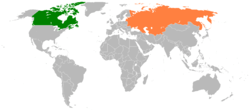Canada–Soviet Union relations
 |
|
Canada |
Soviet Union |
|---|---|
Canada–Soviet Union relations were the relations between Canada and the Union of Soviet Socialist Republics (USSR or Soviet Union).
Diplomatic history
Diplomatic relations did not begin until 1941 after the German invasion of the Soviet Union forced the Soviets and the Western Allies to work together. The Soviet Union's first ambassador to Canada was Georgy Zarubin[1]
Prior to that date, relations had been hostile. Canada had participated in the Allied intervention in the Russian Civil War, and in general mirrored the hostility towards the Soviet Union demonstrated from London. Canadian authorities suspected Soviet involvement in Canadian labour disturbances such as the Winnipeg General Strike of 1919 and the Regina Riot of 1935, while Canada was the subject of unflattering propaganda in the Soviet Union, and subject to the popular front policy. Besides this, Canada had limited powers over her own foreign affairs until the Statute of Westminster 1931.
During the Second World War, aid and arms were relayed through Canada and Alaska to the Soviets, and relations were improved. However, the wartime relationship ended abruptly with the Gouzenko Affair in 1945 and 46. Igor Gouzenko was a clerk at the Soviet embassy in Ottawa who defected to Canada with evidence of Soviet spying in the West. This was combined with the general East-West tension leading up to the early Cold War, led Canada back to an anti-Soviet stance. By 1947 Canadian foreign policy analysts were advocating the creation of a Western Alliance outside of the United Nations. Soon after in 1949, Canada joined the North Atlantic Treaty Organization (NATO), an alliance against the Soviet bloc. In 1950 Canada joined with the United Nations forces in the Korean War against the Soviet-allied North. Once the Soviet Union acquired the nuclear bomb, it became obvious that any Soviet attack on the US would go through Canadian airspace. This led to the construction of a series of linked radar stations across Canada, including the Distant Early Warning Line, and Canada's entry in the North American Aerospace Defense agreement (NORAD) with the US.
After the death of Soviet leader Joseph Stalin, Canada hoped tensions would ease, and then Secretary of State for External Affairs Lester Pearson traveled to the Soviet Union for talks with Nikita Khrushchev in 1955, the first NATO foreign minister to do so. However, tension arose again over the Hungarian Revolution and Suez Crisis in 1956. In 1962 the Tory Prime Minister John Diefenbaker caused a crisis of his own by refusing to put Canadian forces on alert during the Cuban Missile Crisis, and by agreeing to acquire nuclear-equipped interceptor aircraft and Bomarc missiles from the US to use against Soviet bombers.
After Pierre Trudeau came to power in Canada, Canadian policy changed dramatically. Trudeau was more sympathetic to communist nations than other heads of government. Trudeau wanted to lessen Canada's reliance on the United States by forging closer ties with other countries and breaking out of the Cold War straitjacket. During a trip to the Soviet Union in 1971 he identified the United States as a bigger threat to Canada than the remote Soviet Union. The Americans, he said, are "a danger to our national identity from a cultural, economic and perhaps even military point of view." Eventually Trudeau backed away from his "Third Option" policy and returned to the Western fold. However, at the end of his tenure, when he believed that tension between the US and Soviet Union were again too high, he launched a peace mission to Moscow which the Americans did not approve of. Tensions between the US and the Soviet Union eased soon afterwards.
The government of Progressive Conservative Brian Mulroney cast a much more critical eye on the Soviet Union, despite the changes produced in that country by Mikhail Gorbachev's perestroika and glasnost reforms. As late as January 1989, foreign minister Joe Clark still identified the Soviets as a threat to the West, by May however, he spoke approvingly of Gorbachev's reforms. Canada's changed position was fully shown in November 1989, when Prime Minister Mulroney visited the Soviet Union, accompanied by more than 200 representatives of Canadian business. Numerous agreements were signed during the visit, the most important of which was a Political Declaration calling for Canadian-Soviet cooperation in such areas as the environment, the Arctic, terrorism, and the drug trade. Canadian-Soviet relations were now on friendly terms, until January 1991, when Gorbachev cracked down on independence-seeking Lithuania and Latvia, prompting Canada to suspend credit and technical aid to the Soviet Union. During the 1991 Soviet coup d'état attempt new foreign affairs minister Barbara McDougall, evoked much criticism by indicating that Canada could work with the plotters, a position that was particularly embarrassing when Gorbachev was quickly returned to office.
As the Soviet Union fell apart, Canada moved speedily to establish full relations with Lithuania, Latvia, and Estonia. It acted even before the United States, and in December 1991, Canada was the first Western country to recognize the independence of Ukraine, due to its large population of Ukrainian immigrants. With Gorbachev's resignation that month, the Soviet Union ceased to exist, prompting Canada to recognize Russia as an independent state.
Cultural relations
Both countries competed in the sport of ice hockey such as the 1972 Summit Series and its sequel in 1974. The Soviet Union competed in the Rendez-vous '87 against the NHL All-star team only to win Game 2 5-3.
See also
References
- ↑ Time Northern Neighbours
